With football leagues beginning all over Europe, teams are looking to put their new signings to good use and build on any success from the prior campaign. Newcastle United are no different in that sense, but there is a real buzz amongst the fans since the club gained new ownership, with thanks also going to Eddie Howe for guiding them to a top-four finish, finishing above the likes of Liverpool and Tottenham to qualify for the UEFA Champions League.
The Toon Army had big hopes for the summer transfer window, and the club has provided – players like Sandro Tonali and Harvey Barnes have both joined Howe’s team, and both had a positive impact in the season opener vs Aston Villa.
It would be fair to say that Newcastle were favourites for this tie before the first whistle, but not many predicted the five-goal showing in an opening day fixture against a team who themselves enjoyed a fine 2022/23 season in Aston Villa. This tactical analysis will look at two critical areas of Newcastle’s tactics that contributed to them picking up a 5-1 win.
The analysis will cover how Newcastle played in possession & build-up play – their approach of playing out from the back and the impact of their midfield in attack.
Newcastle lineup

The 4-3-3 not only suits the personnel at Howe’s disposal but also the way he wants his team to play in and out of possession – we saw that against Aston Villa. The back four and goalkeeper remained the same as last season, with there being some surprise that Dan Burn still starts at left-back in a high-energy, possession-based team.
The midfield trio, on paper, is full of talent, which also translated onto the pitch. Bruno Guimarães occupied the deeper midfield role, with Joelinton and new signing Sandro Tonali sat ahead of him. The latter played a vital role in Newcastle’s attacking tactics, as the analysis will show in more detail below.
Anthony Gordon won a lot of plaudits for his performance. This display included determination, hard work, and courage alongside his technical ability on show on the left flank, with Alexandar Isak leading the line.
Newcastle’s attack-minded midfield
There are several ways to set up a midfield unit in a 4-3-3, both in terms of positioning and instructions, and Newcastle’s setup in this fixture played a massive part in them being so dangerous in the final third. Tonali and Joelinton were both very involved in attacking proceedings and showed a fantastic understanding of what their manager wanted from them. This segment of analysis will look at how Newcastle’s midfield unit operated in attack.

From the first whistle, Newcastle attacked with aggression, intent, and a certain level of directness to their play. Direct, not in the usual sense in terms of going long into the striker, but playing forward quickly rather than slowing down lateral possession.
The build-up for the first goal gave us a preview of the midfielders combining with the wingers in the final third as Joelinton played a well-weighted pass into the path of Gordon. Joelinton wasn’t the only midfielder involved in this attack, though, as you will know if you saw the game!
Tonali showed brilliant yet subtle movement to free himself from being marked, giving him the best chance of connecting with Gordon’s left-footed cross.
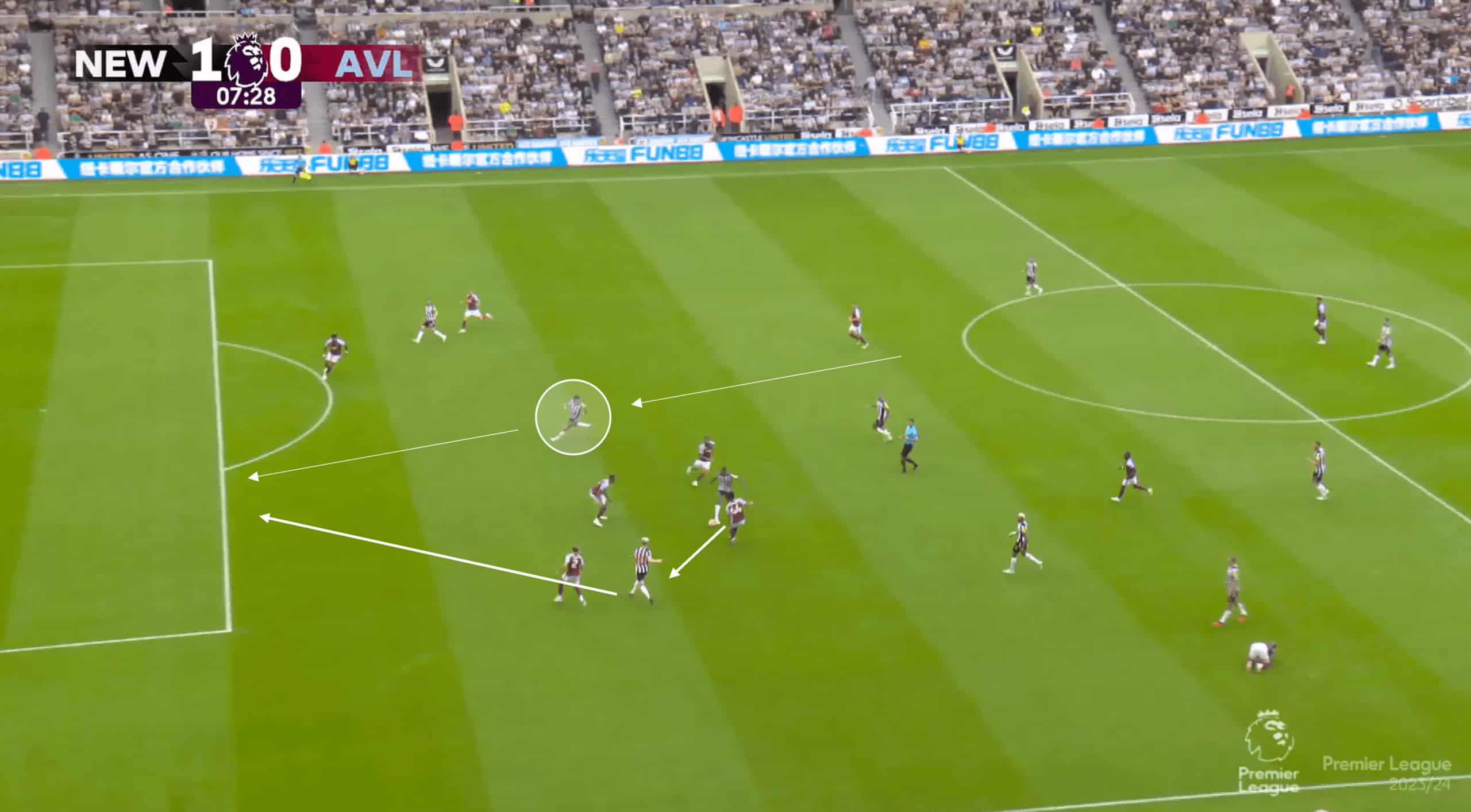
Just moments after scoring on his debut for the Toon, we got more of a taste of what to expect from the former Milan player. Tonali started the move slightly deeper than you see above and was marked by a Villa man – the opponent then left his post to close the ball down, encouraging Tonali to take advantage of such a poor decision.
He did exactly that, making a powering run through the middle into space in the Villa defence. The Italian combined with Gordon again to take the ball through on goal but was only able to force a save from Emi Martinez in the Villa goal. This level of attacking desire and aggression allowed Howe’s team to attack with that directness and speed, something Villa really struggled to adapt to.

Joelinton and Tonali seem to have struck quite the partnership with each other, combining in crucial areas in midfield, just like the example you see above. Guimarães fires the ball into a confident, composed Joelinton, who bounces the ball to Tonali using a flamboyant flick – the Italian then slots a perfectly-weighted pass into the path of fellow debutant Harvey Barnes, who then claims the assist for Callum Wilson’s goal to make it 3-1.
A free-flowing, easy-on-the-eye piece of attacking football that the Newcastle fans will be drooling over – Tonali and Joelinton’s link-up play being a fundamental part of the build-up to that goal.
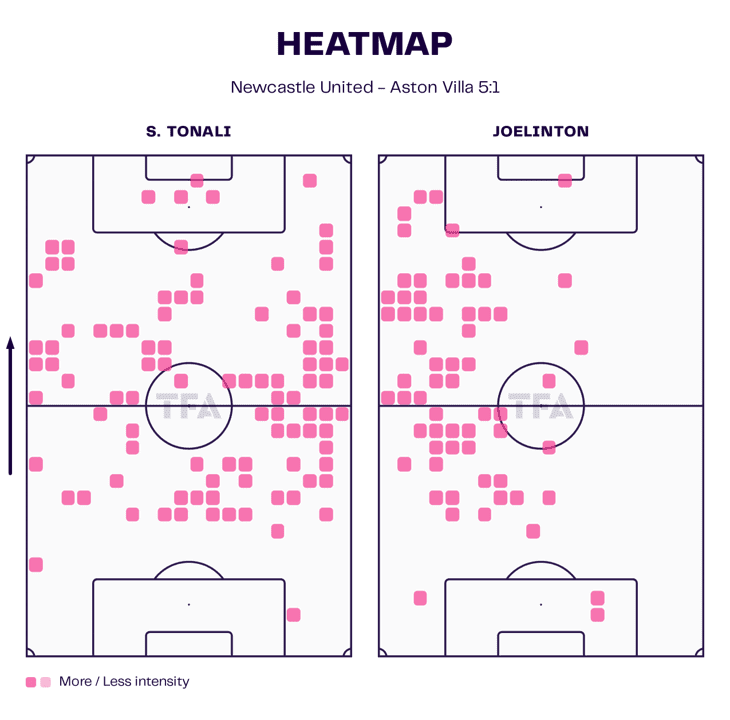
This visual allows us to see where the two midfielders (Tonali & Joelinton) operated in an attacking sense and a defensive one. What jumps out instantly is that Joelinton’s attacking involvement, and his defensive involvement for that matter, occurred either centrally or on the left flank – just as we saw in the build-up to Newcastle’s first goal of the day.
Tonali, on the other hand, would roam and pop up across all areas in midfield and the final third – his clever positioning and off-the-ball movement are a big part of his game.
Toon playing out from the back
Howe’s side looked confident on the ball in every area of the pitch – his side now has an almost arrogant swagger to it but still has a vital balance to it, which is why they were able to breeze past Villa! They didn’t dominate possession in a way that Manchester City may do regarding having a large share of it. Still, their 53% of possession against Villa was calculated and very well executed.
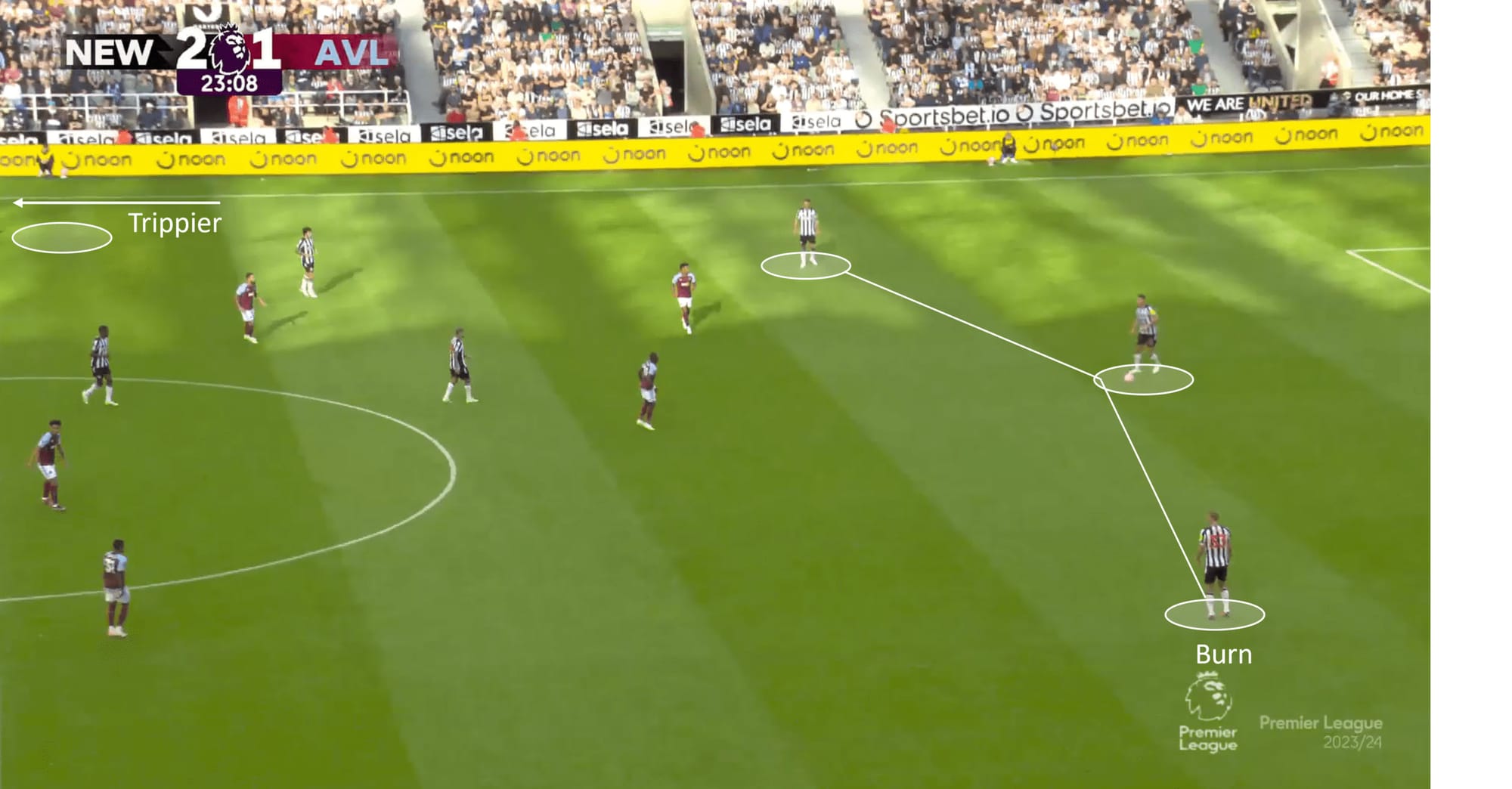
Earlier on, we touched on Newcastle’s lack of left-back options that would typically suit an attacking possession-based team. As solid as he is defensively, Dan Burn isn’t the most gifted on the ball compared to other full-backs in the top four. Yes, Matthew Targett is another option for Howe, but he also doesn’t possess the star quality of a Champions League player.
Nevertheless, Burn was effective enough in this fixture. When looking to build attacks from their own half, Newcastle could be seen to set up like they are in the image above – Burn tucking in to make a makeshift back three, and Kieran Trippier pushed high and wide on the right flank, like an extra midfielder.
To provide some balance, we would see Gordon on the left flank drop in a little deeper to assist the play rather than stay high on the shoulder of the last defender.
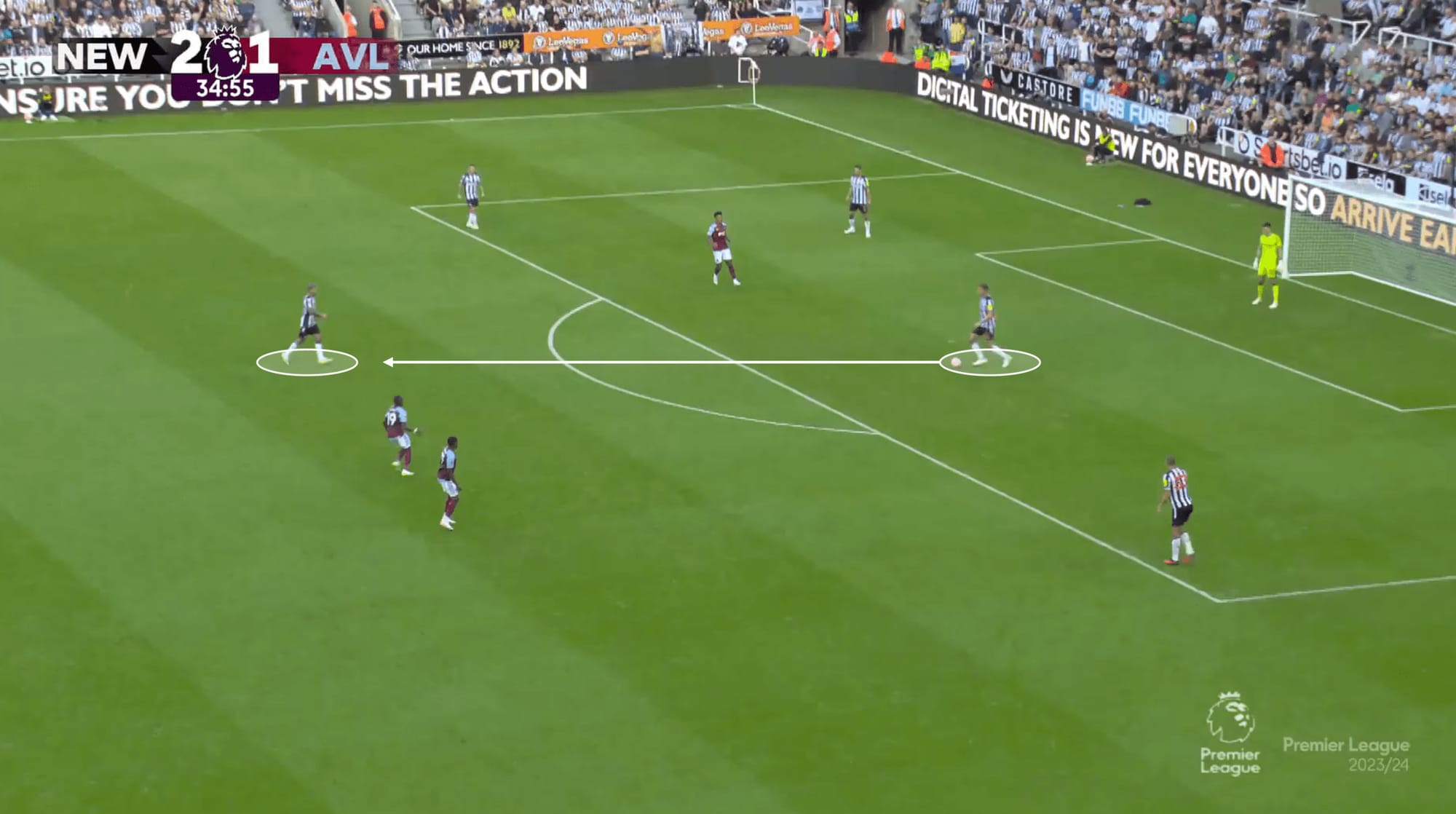
Newcastle utilised the technical ability and awareness of Guimarães when it came to playing out from the back in deep areas, with the Brazilian midfielder often dropping in deep to offer himself as a close outlet.
A small yet imperative detail if Newcastle are to build attacks within their current tactics, as Guimarães has the opportunity to play several passes for his next move after receiving the ball. He could play a pass out to either full-back, go more direct into Isak, or drive forward himself, but there is a fourth option with more minor details.
Guimarães opted to bounce the pass back to the defender, which may seem simple and ineffective, but consider the Villa reaction to Guimarães getting the ball – they squeeze in to press him, allowing his teammates to spread wide and open the pitch up so that when Guimarães does return the ball back to the CB, he has more options to pass forward into.
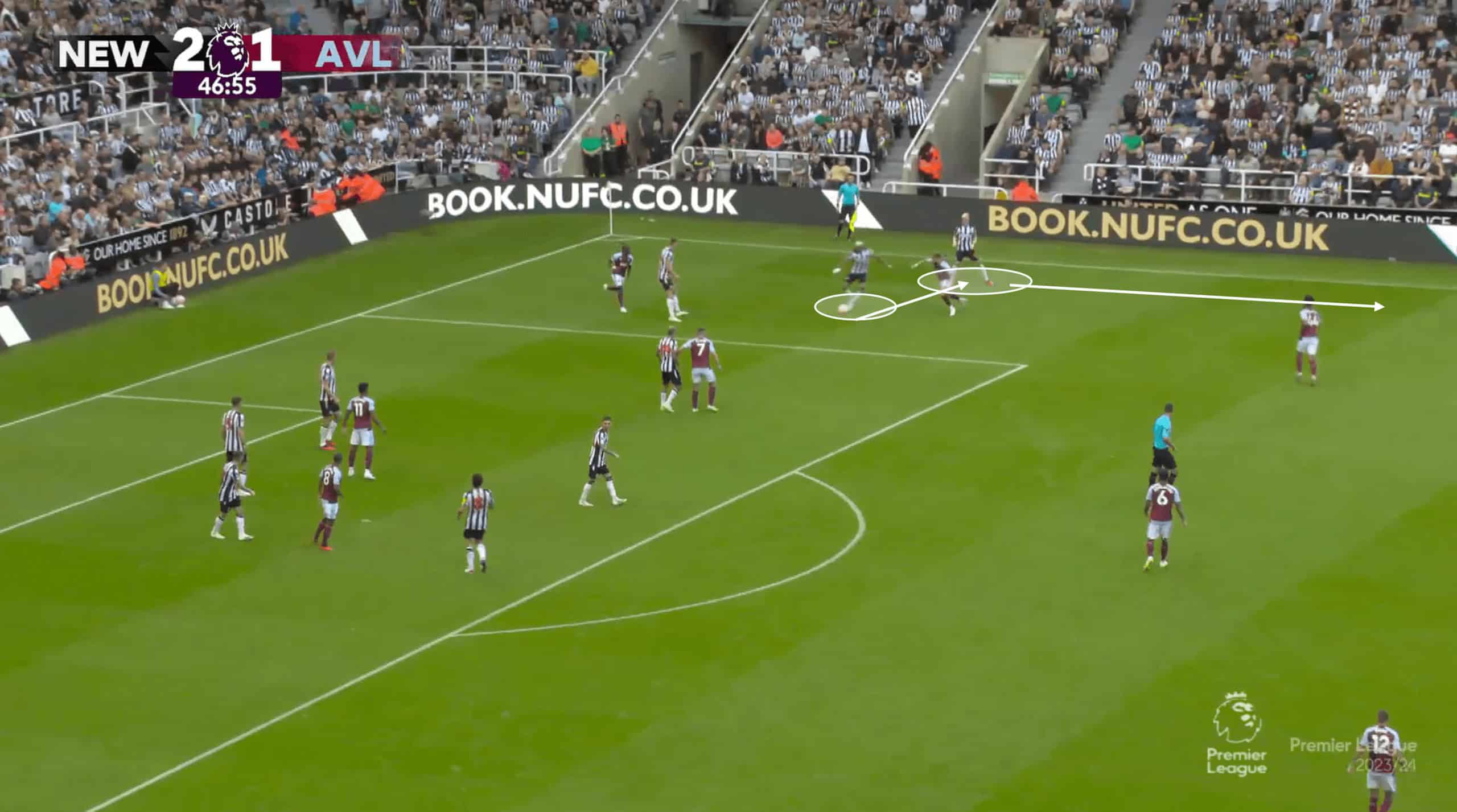
Playing out from the back takes a certain level of confidence and ability. Playing out from the back, deep in your half under immense pressure, takes both of those things and then some, but it is an action we often see from the Toon. The example above captures it nicely – Joelinton had tracked back to aid his side’s defending against a Villa attack, with the ball ending up at his feet.
Now, look at his positioning in the image above and how tight that area is, thanks to Villa’s presence. Nobody would’ve blamed Joelinton for simply going long on this one to relieve the pressure, but instead, the midfield feigned a clearance before hooking a reverse pass into Gordon – a brave yet perilous move that did pay dividends. Gordon took the ball well and instantly knew he wanted to carry it forward, which he did, before winning a foul.
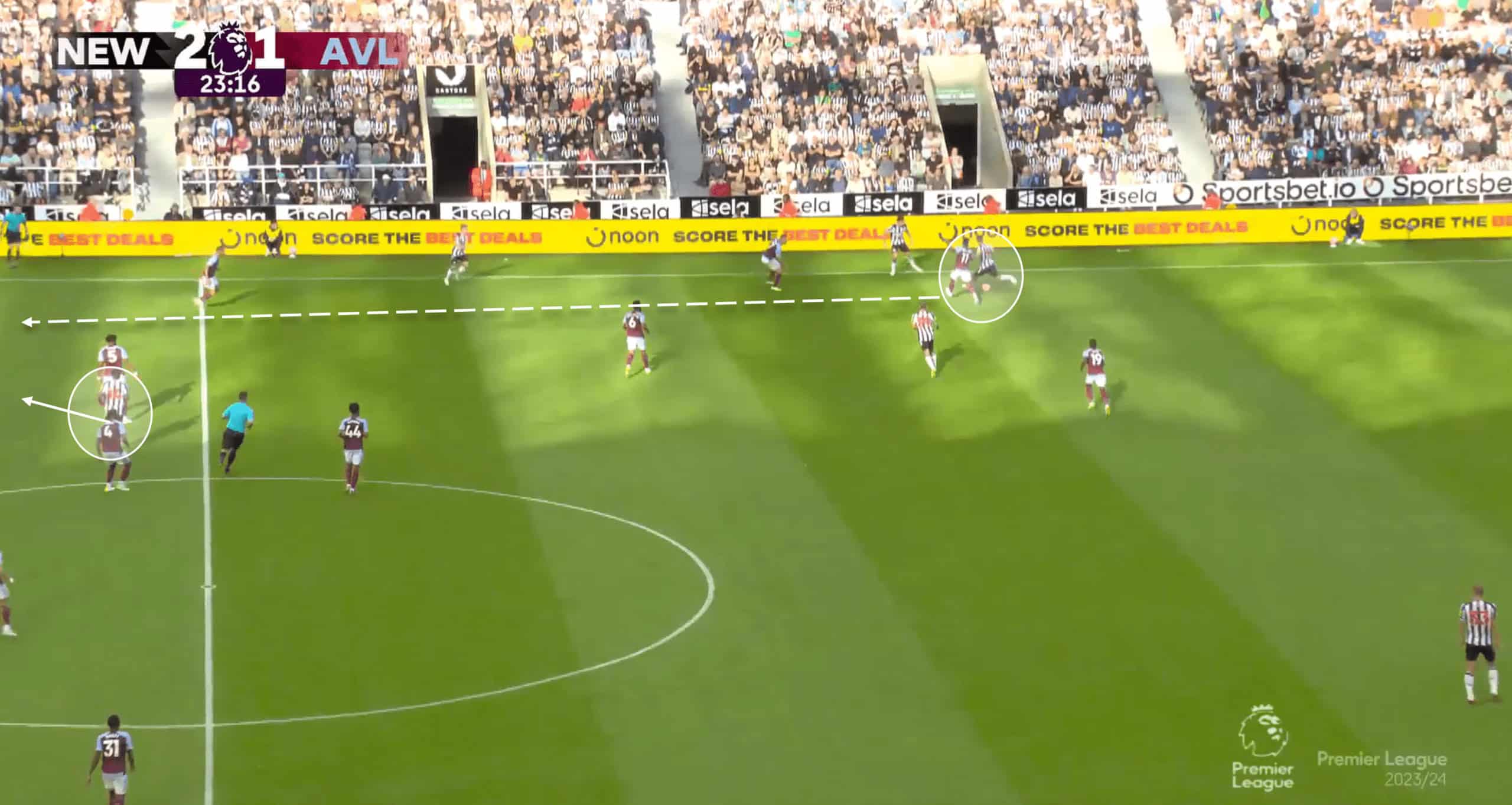
Despite playing out from the back well on a regular basis, Newcastle still had a plan B in place as, well, it is impossible to play through the thirds every time you have possession, and as you can see, Villa’s presence in the image above forces Newcastle’s plan B. A long ball into the channel is a classic move made more effective thanks to Isak’s quick reactions and awareness; his pace helps as he darts across to meet the long pass.
Conclusion
A dream start for Newcastle in many different ways. The win, the emphatic scoreline, and Tonali silencing any doubters that he couldn’t cut it in the Premier League will all be incredibly satisfying for Toon fans. Villa will be devasted – losing like that on the season’s opening game can be a real blow. They weren’t as terrible as the scoreline suggested over 90 minutes, and they certainly showed flashes of the team we saw last season, but they clearly need more time to find their feet this season.






Comments